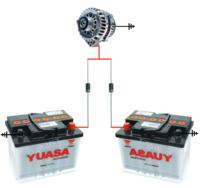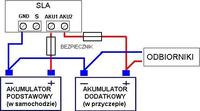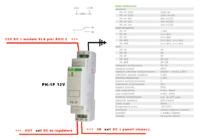Hello
Will such a solution work?
The point is that after the charging process is completed, the current between the batteries does not wander. What is it for? 1 car battery, 2nd for use on the plot, sometimes a 12>230 inverter is connected to it. I would not like to lead to a situation where both batteries will be discharged and I will stay on the plot for the night...
To protect against the "return" of the current, I came up with the use of rectifier diodes, I do not know if this is the optimal solution and what value to give the diodes, or maybe it is better to use some electronic circuit that will work better in my case?

Thank you for your help.
Regards
Will such a solution work?
The point is that after the charging process is completed, the current between the batteries does not wander. What is it for? 1 car battery, 2nd for use on the plot, sometimes a 12>230 inverter is connected to it. I would not like to lead to a situation where both batteries will be discharged and I will stay on the plot for the night...
To protect against the "return" of the current, I came up with the use of rectifier diodes, I do not know if this is the optimal solution and what value to give the diodes, or maybe it is better to use some electronic circuit that will work better in my case?

Thank you for your help.
Regards






